universal (table rotates in plan view) and is used for helical milling
Ram & Turret: Light weight machine tool with slotter on one end of turret. No power feeds.
Special Purpose: For production usage. Usually more rigid construction.
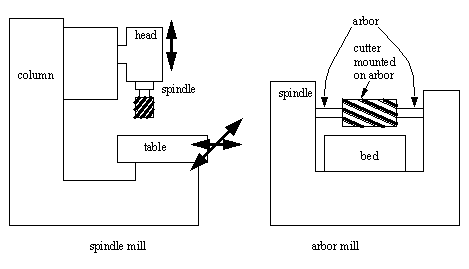
8.1.1 Types of Milling Operations
• Typical operations re pictured below

• The advantages of arbor milling are,
The cutter is held more rigidly on the spindle nose
There is less variation in the arbor torque
The teeth responsible for surface finish do not encounter the hard mill scale
Two similar side and face cutters are mounted on the same arbor, with spacers to separate them.
This allows two sides of a part to be cut in a single pass.
Many dissimilar cutters are mounted on the same arbor at the same time.
When the work is passed under the cutter, multiple cuts are made in a single pass, reducing alignment problems, and decreasing operation time.
8.1.2 Milling Cutters
• The family milling cutters include a number of basic operations, but in general they will cut with some combination of the end and/or the sides.
End Mills: The face and sides at the bottom end of this tool are used for plunge cutting (two flutes) and side and end cuts (four flute).
Plain: These mills are used to cut with the sides only. They are generally mounted on an arbor.
Face: This cutter is held on a spindle nose.
8.1.3 Milling Cutting Mechanism
• In milling each tooth on a tool removes part of the stock in the form of a chip.
• There are two types of cutting actions,
Peripheral: The teeth at the periphery do the cutting
Face: The teeth on the face of the cutter remove metal.
• The basic interface between tool and work is pictured below. This shows a peripheral milling tooth.
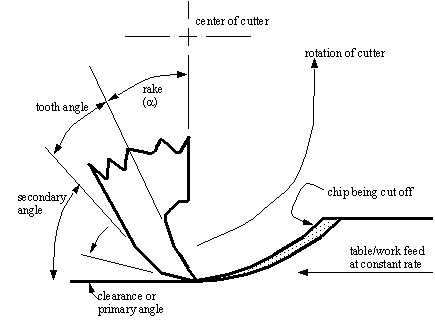
• The milling method shown above is called up-cut (or conventional) milling. In this case the table is moving towards the cutter, opposing the cutter direction. The basic steps of chip cutting here are,
1. As the tooth makes contact with the surface, the tooth begins to push down. As the tooth continues to turn, it reaches a point at which the pressure has built up to a high level, and the tooth begin to dig in.
2. As the tooth starts to dig, it cuts down, and the metal chip begins to shear off.
3. The tooth continues to cut the chip off, until it reaches the surface of the material. At this point the chip breaks free, and the cutting forces drop to zero.
• Because the cutter does not start to cut when it makes contact, and because the advance moves high points past the cutter contact, the surface has a natural waviness.

• If a cutter has straight flutes, then a torque profile for it might look like,

• The peak arbor torque can be smoothed out by using helical cutting blades, so that there is always a cutter in contact at any one time.
• When the cutter rotation is in the same direction as the motion of the work being fed, it is referred to a Down-cut, or climb milling.
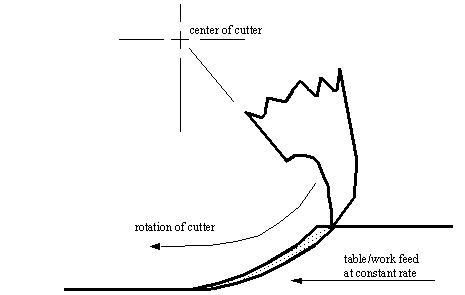
• When this cutter makes contact with the work, it must begin cutting at the maximum torque. As a result, a back-lash eliminator must be used to take play out of the system.
The cutter forces are directed into the table, which reduces fixture forces, and allows thinner workpieces
There is less radial pressure on the arbor
Better surface finishes obtained because there is no “dig-in”
• Milling is somewhat different than drilling and turning,
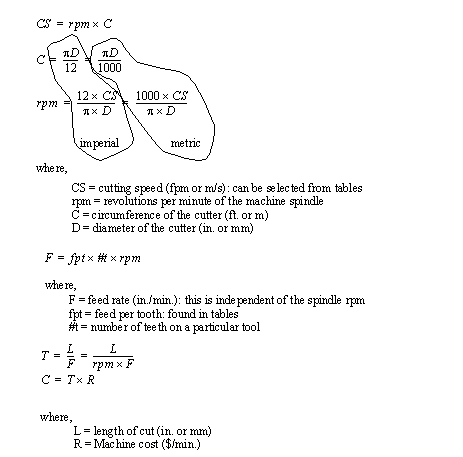
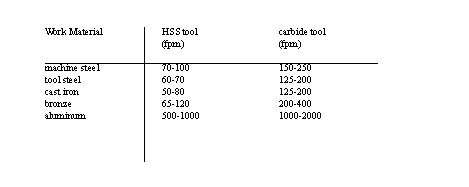
• Typical feed per tooth values for HSS cutters, [Krar]
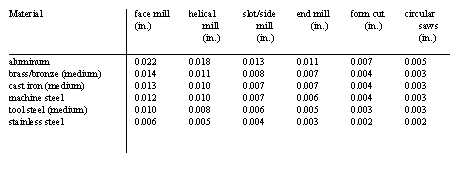
• Typical feed per tooth values for cemented carbide (tipped) cutters, [Krar]
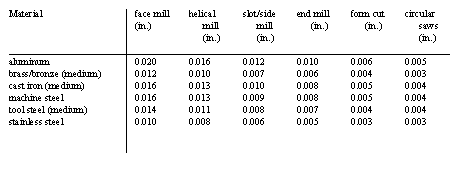
8.2.1 The mrr for Milling
• considering the parameters defined in the discussion of speeds and feeds, etc, the mrr is given below,
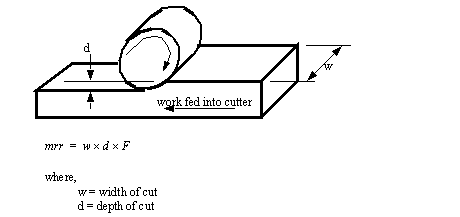
8.2.2 Process Planning for Prismatic Parts
1. Cut off the stock slightly larger than required.
2. Cut the basic outside diameter to size using a milling machine.
3. Lay out the basic features of the parts (in manual setups, this involves coating the surface with a blue stain, this is then cut and marked).
4. Use a bandsaw to rough cut the work.
5. On the mill, cut steps, radii, angles, grooves, etc.
6. Lay out the holes to be drilled, and then drill them.
8. Grind any surfaces that require it. Ground surfaces should generally have 0.010”
8.2.3 Indexing
• It may sometimes become necessary to rotate parts on a milling machine, beyond the rotation offered in some beds (e.g. Universal Milling Machine).
• Some of the applications that require this capability are milling of,
• This method can be done with a dividing head. This is basically a worm gear unit. As the crank is turned, the cylindrical gear will drive the round gear. This will result in an apparatus that takes large motions in the crank, and results in small rotations of the work. When coupled with a scale of some description this becomes very accurate.
• If a worm wheel has 40 teeth, each rotation of the crank will result in a rotation of 40/360 degrees, or 1/40th of a rotation. This means the rotation is 40:1.
• There are two methods of indexing,
Direct Indexing: A notched plate is located so that the crank shaft can be fixed at set positions (notches).
Simple Indexing: Work is rotated by turning a crank. The crank is finally positioned using a plate with holes, and a sector arm. (The sector arm is used to count off the divisions on the plates)
• An example of the calculations involved is,

• Another example of indexing considers a rotation of 50 degrees,

• Differential indexing: is sometimes required to move plates both forward and backward part of a turn to obtain correct spacing. i.e., output shaft through gear train drives the index plate. XXXXXXXXXXXXXXXXXX
• Helical milling: the machine table is rotated through a helix angle. The machine lead screw drives the dividing head. Work is rotated while the machine table feeds. XXXXXXXXXXXXXXXX
• CAM Milling: requires a milling machine with a rotating vertical head. The dividing head is driven by the machine lead screw.
Problem 8.1 1. A 2” diameter milling cutter with 8 teeth has been selected. What is the table feed if we are milling at 80 ft./min. with a tooth load of 0.004”/tooth?
Problem 8.2 Calculate the machine tool spindle speeds for the following,
a) milling with a 3/4” high speed steel cutter in tool steel work. The CS is 60 ft./min.
b) milling with a 150mm diameter tungsten carbide tipped face cutter in stainless steel work. The CS is 65 m/min.
Problem 8.3 You are given a block of aluminum (5” by 5” by 5”) and you must mill off a 1/16” layer. Using the tables for speeds and feeds, and using the other details provided below, determine a cost for the operation. Milling cutter - high speed steel; diameter 2”, 10 teeth with a tooth load of 0.004” per tooth, cost for the machine is $20.00 per hours.
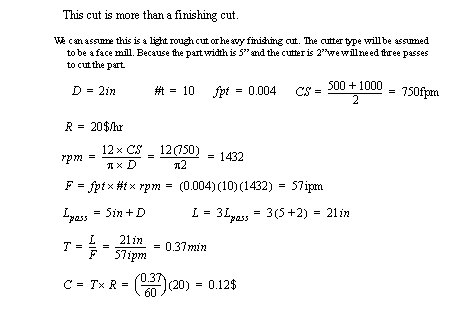
Problem 8.4 Which of the following statements is true for milling?
a) milling cutters can cut with the face and peripheral teeth.
b) the cutting edge moves opposite to the direction used in lathes.
c) indexing is used to cut rounded surfaces.
Problem 8.5 What are the advantages of upcut and downcut milling?